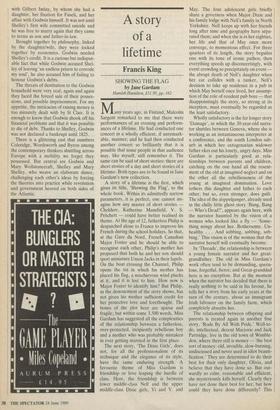Practising what the other preached
Antonia Douro
THE GODWINS AND THE SHELLEYS by William St Clair
Faber, f20, pp.572
William St Clair's look at the philo- sopher and the poet inspects the links in the chain that bound Godwin and Shelley as moralists, journalists, novelists, deists, creditor and debtor, father and son-in-law, pursuer and pursued. Their reputations as much as their lives provide the perfect foil for investigating the claims, revealing the similarities and differences, their heroic stands for intellectual integrity and the inevitable compromises that betrayed them. But because Godwin was the author of Political Justice and outlived Shelley, it is really his story.
He was born to abject poverty in an enormous family mutilated by infant mort- ality, the son of a dissenting minister who taught of a wrathful God demanding utter resignation. At the age of 11 Godwin began his education for the ministry in the house of a Sandemanian — a member of the strict Calvinist sect. Godwin became known for his calm dedication and passion- ate argument. From this severe regime emerged, almost miraculously, a young man so determined to think for himself that he rejected his ministry and set out, penniless, to teach Independence and Hope. St Clair's narrative is delightfully peppered with irony — 'as part of his training Godwin was assigned a servant to convert, but her chief contribution to his education was to tell him dirty stories'.
Swiss soldier ant. Temptation from intellectual honesty took many forms.
By 1789 Godwin had been writing for five years about French politics and read- ing the philosophies of the French Enlight- enment. He numbered Tom Paine, author of The Rights of Man, and Thomas Hol- croft amongst his friends and together they believed that their writing could influence the direction of events. When the Terror swept Paris they were dismayed. Godwin's An Enquiry Concerning Political Justice and Its Influence on General Virtue and Happiness states his belief in the essential good of the individual which, undisturbed by corrupting institutions, would grow in a society of minimal government. It was published in 1793 as Britain declared war on France at a time of multiple prosecution against all types of reformers — bill- stickers, booksellers and printers, let alone theorists in print. It was an act of tremendous courage. Shelley was seven months old.
They were to meet some 19 years later when Shelley had adopted Godwin's theory of 'Perfectibility' and had read every scrap of Godwin's writing he could lay his hands on. Like his mentor at 19, Shelley was a scholar, perfectly in tune with the spirit of 1793. But he was not as biddable as Godwin's other disciples had been and he came ready to challenge Godwin on any points of compromise that had slipped in during the intervening years. It was after writing Political Justice that Godwin discovered poetry, sex, requited love, and in one dramatic week gained a daughter and lost a wife. In love, Godwin was a figure of fun; Charles Lamb reported that 'he smiles without occasion and wrig- gles as fantastically as Malvolio . . . he lays down his spectacles, as if in scorn, and takes them up again from necessity.'
Godwin's romance with Mary Woll- stonecraft, the author of the Vindication of the Rights of Women, was as severe a test to his philosophy as the appearance of Shelley was to prove. Committed to seeing marriage abolished, he married Mary Wollstonecraft to legitimise her status, their unborn child and her illegitimate daughter. His admirable detachment and belief in impartiality, born of a loveless childhood and rigid education, were under siege.
Shelley as a young man suffered no such blocks of affection. At 17 he was married, although he thought the institution 'an evil of immense and extensive magnitude', because it was 'fair to Harriet', his wife. Within months of inviting himself to God- win's table, Shelley abandoned his pre- gnant wife and left the country with God- win's daughter and her step-sister. When Godwin failed to apply the tenets of Political Justice to this move, Shelley and Godwin's daughter were dismayed. They pointed to the Memoirs which Godwin published after Mary Wollstonecraft's death which intimately recorded her liaison with Gilbert Imlay, by whom she had a daughter, her fixation for Fuseli, and her affair with Godwin himself. It was not until Shelley's first wife committed suicide and he was free to marry again that they came to terms as son and father-in-law.
Brought together by philosophy, linked by the daughter/wife, they were locked together by economics. Godwin needed Shelley's credit. It is a curious but indisput- able fact that while Godwin accused Shel- ley of leaving 'an endless prison to corrode my soul', he also accused him of failing to honour Godwin's debts.
The threats of destitution to the Godwin household were very real; again and again they faced the forced sale of their posses- sions, and possible imprisonment. For my appetite, the intricacies of raising money is too minutely dealt with by St Clair. It is enough to know that Godwin shook off his financial problems and that it was possible to die of debt. Thanks to Shelley, Godwin was not declared a bankrupt until 1825.
There is a glittering cast that numbers Coleridge, Wordsworth and Byron among the contemporary thinkers shuttling across Europe with a mobility we forget they possessed. But central are Godwin and Mary Wollstonecraft, Shelley and Mary Shelley, who weave an elaborate dance, challenging each other's ideas by forcing the theories into practice while revolution and government heaved on both sides of the Atlantic.











































































 Previous page
Previous page